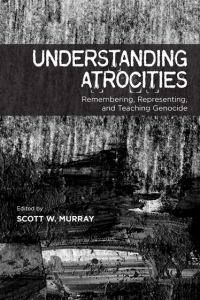 As a middle and high school history and social studies teacher, I have taught about the Holocaust and other genocides for many years. At the beginning of my career, students in my classes would have encountered only the Holocaust, but, recently, I have broadened my curriculum to include many additional examples and aspects of genocide. Despite growing efforts to expand the field of genocide education, there is still a gulf between academic scholarship and curriculum and practice within secondary classrooms. Scholarship, often inaccessible for secondary educators, is slow to make its way into course content. Understanding Atrocities: Remembering, Representing, and Teaching Genocide (2017) is the latest among recent efforts to bridge this gap and recognize the role of educators at all levels and community organizations in conversations about genocide education. This collection expands the conversation to include many voices, especially concerning the teaching of genocides other than, or in addition to, the Holocaust.
As a middle and high school history and social studies teacher, I have taught about the Holocaust and other genocides for many years. At the beginning of my career, students in my classes would have encountered only the Holocaust, but, recently, I have broadened my curriculum to include many additional examples and aspects of genocide. Despite growing efforts to expand the field of genocide education, there is still a gulf between academic scholarship and curriculum and practice within secondary classrooms. Scholarship, often inaccessible for secondary educators, is slow to make its way into course content. Understanding Atrocities: Remembering, Representing, and Teaching Genocide (2017) is the latest among recent efforts to bridge this gap and recognize the role of educators at all levels and community organizations in conversations about genocide education. This collection expands the conversation to include many voices, especially concerning the teaching of genocides other than, or in addition to, the Holocaust.
Teaching Genocide and Mass Violence
Was Hitler a bully? Evan Selinger, professor of philosophy at the Rochester Institute of Technology, shared in an essay in Slate how his 5-year-old daughter’s teacher compared the “worst criminal in history to a playground tormentor.” Perhaps an extreme example. Yet to understand this increasingly common trend to educate students about “Bully Hitler,” one must recognize two developments that are currently shaping the way teachers, curriculum writers, and educational institutions in the United States are educating young people about the Holocaust. First, there is a universalization of the Holocaust in an attempt to make its study relevant to students’ lived experiences and to provide them with overt moral and ethical lessons in the form of social-emotional and character education. Second, increasingly, many state legislatures have mandated Holocaust education, often suggesting a study in the form of character education to younger students, some as young as elementary school (5-10 years old). New Jersey’s Commission on Holocaust Education, the entity responsible for ensuring schools meet the state’s Holocaust-education mandate, reminds educators that, “the law indicates that issues of bias, prejudice and bigotry, including bullying through the teaching of the Holocaust and genocide, shall be included for all children from K-12th grade.” Thus, increasingly, students are taught to link the Holocaust with bullying and pushed to contemplate the choices they might have made during the Holocaust, as well as the choices they might make in their school’s cafeterias, hallways, and playgrounds as bullies, bystanders, or upstanders.
 Review of Sarah Donovan’s (2016) Genocide Literature in Middle and Secondary Classrooms: Rhetoric, Witnessing, and Social Action in a Time of Standards and Accountability.
Review of Sarah Donovan’s (2016) Genocide Literature in Middle and Secondary Classrooms: Rhetoric, Witnessing, and Social Action in a Time of Standards and Accountability.
In 2016, Michigan became the newest state to enact legislation to mandate the instruction of genocides for secondary students, specifically citing the Holocaust and Armenian genocide. Michigan joined seven states that have legislative mandates to teach about the Holocaust and genocide in public middle and high schools. Currently, several projects are calling for directives to teach about the Holocaust from all 50 states (e.g. New York’s Anne Frank Center for Mutual Respect and The Butterfly Project). more...
Early this week Frank Navarro, a United States Holocaust Memorial Museum trained teacher who has taught at Mountain View High School in California for 40 years, was put on leave after a parent complained about the parallels he was drawing in his world studies class. He was accused of comparing Trump to Hitler, but in actuality he had only pointed out the connections between Trump’s presidential campaign and Hitler’s rise to power.
On September 1 of this year, Holocaust scholar Michael Berenbaum wrote in the article With gratitude toward Donald Trump, how as an educator, he was grateful to Trump for making it easier for him to explain to his students, how it was possible for the Nazis and Hitler to come to power. In my own classroom, it is my students who have made the connections, as I certainly did not have to spell it out for them. We all agree that Trump is not Hitler, but certainly the rhetoric and unabashed racism, antisemitism and xenophobia unleashed by his campaign reminds us of the tactics used by Hitler, the Nazis and his followers.
Memory is a tricky thing. Biased and imperfect, it can be willfully deceitful and innocently forgetful. Collective memory is no different, and is perhaps more problematic in that it is often formed and framed by people and institutions with ulterior motives. Even more importantly, collective memory defines our popular conceptions of history’s meaning.
Popular histories are powerful forces in shaping identity and purpose for all societies. Yet, they rarely do justice to the delicate intricacies of the central questions that the pressing issues of human existence ask of us. Popular history marginalizes some of the most essential questions that we face, and yet, it is often the only history to which many young people are exposed. more...
Was Hitler a bully? Evan Selinger, professor of philosophy at the Rochester Institute of Technology, shared in an essay in Slate how his 5-year-old daughter’s teacher compared the “worst criminal in history to a playground tormentor.” Perhaps an extreme example. Yet to understand this increasingly common trend to educate students about “Bully Hitler,” one must recognize two developments that are currently shaping the way teachers, curriculum writers, and educational institutions in the United States are educating young people about the Holocaust. First, there is a universalization of the Holocaust in an attempt to make its study relevant to students’ lived experiences and to provide them with overt moral and ethical lessons in the form of social-emotional and character education. Second, increasingly, many state legislatures have mandated Holocaust education, often suggesting a study in the form of character education to younger students, some as young as elementary school (5-10 years old). New Jersey’s Commission on Holocaust Education, the entity responsible for ensuring schools meet the state’s Holocaust-education mandate, reminds educators that, “the law indicates that issues of bias, prejudice and bigotry, including bullying through the teaching of the Holocaust and genocide, shall be included for all children from K-12th grade.” Thus, increasingly, students are taught to link the Holocaust with bullying and pushed to contemplate the choices they might have made during the Holocaust, as well as the choices they might make in their school’s cafeterias, hallways, and playgrounds as bullies, bystanders, or upstanders.
 Review of Sarah Donovan’s (2016) Genocide Literature in Middle and Secondary Classrooms: Rhetoric, Witnessing, and Social Action in a Time of Standards and Accountability.
Review of Sarah Donovan’s (2016) Genocide Literature in Middle and Secondary Classrooms: Rhetoric, Witnessing, and Social Action in a Time of Standards and Accountability.
In 2016, Michigan became the newest state to enact legislation to mandate the instruction of genocides for secondary students, specifically citing the Holocaust and Armenian genocide. Michigan joined seven states that have legislative mandates to teach about the Holocaust and genocide in public middle and high schools. Currently, several projects are calling for directives to teach about the Holocaust from all 50 states (e.g. New York’s Anne Frank Center for Mutual Respect and The Butterfly Project). more...
Early this week Frank Navarro, a United States Holocaust Memorial Museum trained teacher who has taught at Mountain View High School in California for 40 years, was put on leave after a parent complained about the parallels he was drawing in his world studies class. He was accused of comparing Trump to Hitler, but in actuality he had only pointed out the connections between Trump’s presidential campaign and Hitler’s rise to power.
On September 1 of this year, Holocaust scholar Michael Berenbaum wrote in the article With gratitude toward Donald Trump, how as an educator, he was grateful to Trump for making it easier for him to explain to his students, how it was possible for the Nazis and Hitler to come to power. In my own classroom, it is my students who have made the connections, as I certainly did not have to spell it out for them. We all agree that Trump is not Hitler, but certainly the rhetoric and unabashed racism, antisemitism and xenophobia unleashed by his campaign reminds us of the tactics used by Hitler, the Nazis and his followers.
Memory is a tricky thing. Biased and imperfect, it can be willfully deceitful and innocently forgetful. Collective memory is no different, and is perhaps more problematic in that it is often formed and framed by people and institutions with ulterior motives. Even more importantly, collective memory defines our popular conceptions of history’s meaning.
Popular histories are powerful forces in shaping identity and purpose for all societies. Yet, they rarely do justice to the delicate intricacies of the central questions that the pressing issues of human existence ask of us. Popular history marginalizes some of the most essential questions that we face, and yet, it is often the only history to which many young people are exposed. more...
